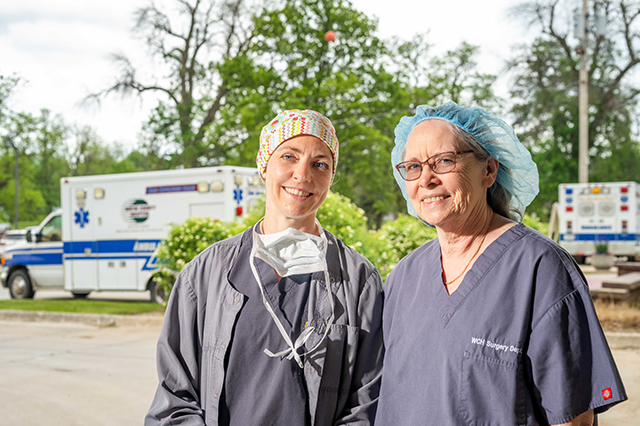
The University of Iowa’s Doctor of Nursing Practice program in nurse anesthesia educates a crucial part of the state’s rural health care system, and provides its graduates with a challenging yet fulfilling experience.
By Tom Snee | UI Office of Strategic Communication | 6-4-2021
Valerie McKinley does a little bit of everything working as a nurse anesthetist.
She might numb a child’s finger so they can get stitches, then give an epidural to a woman giving birth, then anesthetize a patient getting a new knee in the operating room.
And without McKinley, there’s a chance none of those things get done. The hospitals where she works in south central Iowa have no anesthesiologists. All of the anesthetic work at the hospitals—from numbing a minor injury to putting a patient under for surgery and then bringing them back—is done by certified registered nurse anesthetists (CRNAs), registered nurses who have completed several years of graduate education to learn how to administer anesthesia. Of Iowa’s 113 hospitals, 88 rely completely on CRNAs to administer anesthesia to patients, all of them in rural areas.
“I have no idea how they would have anesthesia services at a lot of hospitals without nurse anesthetists,” says McKinley.
The lone training program in the state
The University of Iowa College of Nursing’s Doctor of Nursing Practice (DNP) program—where McKinley earned her degree in 1997—is a key part of providing those professionals, as it’s the only one in the state that educates CRNAs. The program started in 1994 in response to a request to the Board of Regents, State of Iowa, by the Iowa Hospital Association, which was having a hard time recruiting CRNAs, according to Cormac O’Sullivan, clinical associate professor of nursing and program director.
In response, then-Dean Geraldine Felton and John Tinker, chair of the Roy J. and Lucille A Carver College of Medicine Department of Anesthesia, built a program that first awarded master’s degrees and then, in 2010, began awarding the Doctor of Nursing Practice. As the only program in Iowa, it has educated about 30% of the state’s CRNAs. Since its inception, O’Sullivan says, 67% of program graduates have remained in Iowa and 30% have taken up practice in the state’s rural, critical access hospitals.
Applicants are required to be a registered nurse with a bachelor’s degree and at least two years of professional nursing experience in intensive care unit settings. O’Sullivan says the program is very competitive, accepting only 14 students for each class. He would like to accept more, but the program is limited by available clinical experiences required by accreditation bodies.
The rigorous three-year program starts with three semesters of classroom work on campus, with students learning graduate-level anatomy, pharmacology, physiology, and pathophysiology; how-to classes and high-fidelity simulated experiences with anesthesia equipment and administering anesthetic drugs; and additional classes in leadership and health care administration. O’Sullivan says the classes they take and the resources available are geared specifically to anesthesia.
“CRNAs use the same textbooks, same anatomy labs, and receive the same clinical education that anyone learning to provide anesthesia would use,” he says. “Everything is similar.”
Gaining experience across Iowa
After their first year of classes on campus, CRNA students begin a series of rotations around the state to rural and community hospitals in places like Bloomfield, Spencer, Waverly, Manchester, Fort Dodge, and Mason City. They also get experience with more complex cases at University of Iowa Hospitals & Clinics and the Iowa City Veterans Affairs hospital.
By the time they graduate, students have had more than 2,500 hours of clinical time and have provided anesthesia for more than 1,100 surgeries while mentored by a CRNA or anesthesiologist. O’Sullivan says it’s the specialized rural rotation experiences that set the Iowa program apart from any other.
“They get a wider variety of experiences than they can in other programs, practicing in so many different types of settings,” he says.
# # #